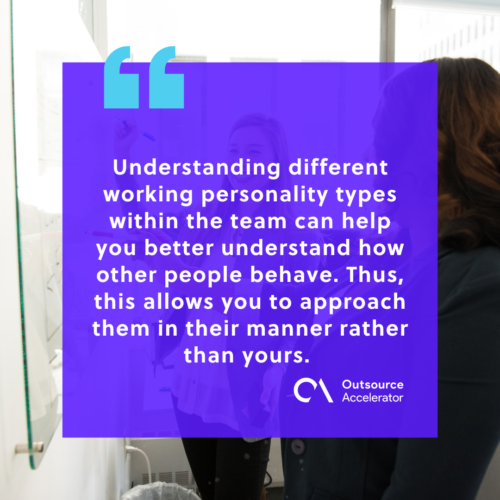Meet the different working personality types, and how to work with them

The workplace is made up of a variety of people; each person has a distinct personality and unique skills and weaknesses.
Understanding your staff members’ different working personality types and how to make the most of each is important if you want to build a productive and harmonious work environment.
An effective workplace must also integrate employees with diverse working personality types to boost employee morale.

What is a working personality type?
A working personality type categorizes employees so you can better match your communication style to what they need as coworkers or team members.
No two people are perfectly similar, and most employees will have characteristics that fall into more than one category. A general understanding of different personality types in the workplace will help you work with your staff to increase their happiness and productivity.
The importance of understanding working personalities
Different working personality types may cause employees to approach their jobs differently – from how they expect to be treated to how they approach their duties.
Every team leader aspires to create a workplace that is free of turmoil, where everyone knows their role and feels empowered to express their creativity. Learning and adjusting to various working personality types is vital to becoming an effective leader.
Understand other people’s behavior
Understanding different working personality types within the team can help you better understand how other people behave. Thus, this allows you to approach them in their manner rather than yours.

Adjust your operations efficiently
You can adjust your operations to match your staff members with a better understanding of the working personality types in your office.
At the same time, employee retention can be increased by better understanding workplace personalities and adapting your management style to suit each type.
Develop your team’s strengths
Recognizing the unique characteristics of each team member and modifying their tasks will help you better manage your team.
You may then see their strengths develop and their flaws gradually get weaker.
Integrate your team
Understanding employee personality types by bringing complementary personalities together and preventing pointless misunderstandings will also improve teamwork and collaboration among your team.
Different working personality types
American psychologist Dr. John Holland once said, “the choice of a career is an expression of personality.”
Dr. Holland suggests that people perform at their best in situations at work that reflect their preferences or personalities. He came up with six personality types called the Holland Codes that the Department of Labor uses to classify careers.
The Holland Codes identify these types as Realistic, Artistic, Enterprising, Social, Conventional, and Investigative. However, there is more to these working personality types.
The right team members help your company move in the right direction and maintain open lines of communication. Here are the different working personality types you may encounter within your team:

1. The analytical (problem-solver)
An analytical is a well-kept employee who prefers to operate within predetermined boundaries. They have identified their most effective working techniques and choose to stick with them.
Analysts are curious and enjoy resolving disputes. They are typically considered the “clever ones” as they are meticulous, exact, rational, and careful. They make sure that nothing falls through the gaps by moving slowly and steadily.
They follow the rules, but their “over-analysis paralysis” can sometimes stall projects and annoy other team members as it prevents the team from moving forward quickly.
Most importantly, these people value consistency, so sudden changes that interfere with their routine may result in conflict.
Any routine modifications should be discussed beforehand with them. By giving them advance notice, you give them time to choose their preferred method of accommodating the changes, ensuring that unforeseen workplace challenges are kept to a minimum.
2. The climber (overworking)
The climber is ambitious and frequently wants to develop their career as rapidly as possible. Having a climber in your team who pursues their progress ethically can benefit business because they are eager to do more work to win favor.
People with this kind of working personality type are straightforward, determined, and decisive. They enjoy a challenge, are risk-taking, work quickly, and focus on achieving goals.
However, they can also be seen as impatient, insensitive, dictatorial, and domineering. You should keep an eye on other staff members’ reactions to climbers to ensure they are not making their teammates uncomfortable by acting too egotistical.
3. The motivator (expressive)
Motivators are enthusiastic and motivating, as the term implies. They think broadly, are upbeat, and usually focus on a vision. They are a cheerleader and can handle many tasks at once.
However, motivators might occasionally lose track of reality when they struggle with concentration. They tend to get all over the place because they try to do too much at once.
Motivators advocate pushing themselves and other team members to produce as much labor as they can. This can result in stepping beyond their bounds and providing coworkers with unnecessary incentives.
While it is crucial to ensure that other employees are not pushed too far from their comfort zone, the motivator can be helpful in boosting their peers’ productivity.
4. The performer (the popular)
An employee who enjoys being the center of attention at work is referred to as the performer. When discussing a project, they are overly participative and quick to chime in with their contributions. They try to stand out in talks that are not about work.
Performers may exhibit people-pleasing behavior when interacting with high-ranking staff. Meanwhile, they may show motivator or perfectionist behaviors when conversing with their team members who are more open to criticism and suggestions.
The performer is one of the most well-liked employees because they are social, but some staff members might be turned off by their personality and talkativeness.
People with this kind of working personality do not require special training as long as they establish excellent interactions with other employees. However, you might decide to talk to them about exercising restraint if their actions present otherwise.
5. The anxious (worrier)
Worriers within the team frequently exhibit signs of stress over their workload. They need constant validation to ensure they are fulfilling expectations and providing relevant results.
People with this working personality type constantly speed through tasks while grumbling to anybody who will listen about their workload. They struggle to fulfill deadlines and always need more time.
Nevertheless, they might make up for it by putting in more hours than everyone else and trying to keep up.
Building someone’s confidence is crucial when you spot a potentially anxious person on your team. They may get more self-reliant and do better when their worry subsides because they will not be second-guessing their decisions.
6. The perfectionist (organized)
The perfectionist strives to do their best work at all times. They have a keen eye for detail and can produce stunning results. They value structure, order, progress, and rules.
Problems arise if someone’s time management is poor, focusing too much on perfection over meeting deadlines. Also, if someone has high standards but is intrusive in their coworkers’ work and responsibilities, this can make their teammates uncomfortable.
If you have a perfectionist on your team, keep an eye on them to make sure they are not overworking themselves and others. Provide constructive feedback on their work to make them feel more at ease.
Meanwhile, teach them the value of working smarter to help them find the optimal balance between quality and speed.
Managing different working personality types
Naturally, you will encounter different kinds of people at work. As a team leader, you must know how to manage and deal with them.

Depersonalize your feelings
Try to depersonalize your feelings and accept individuals for who they are rather than saying negative things about them. Basing your judgment on your own preferences could lead to frustration on your part.
This is why it can be simpler to let things go and accept others for who they are when you look at them objectively.
Embrace your team’s differences
Do not hesitate to ask the reasons for someone’s viewpoint or working habits. Consider your team’s differences as beneficial rather than antagonistic to better stretch and challenge your ways of thinking and doing things in the workplace.
Focus on a shared agenda
When the differences appear too complicated, concentrating on the shared agenda or objective might help bring team members together.
Although you may have diverse perspectives and communication styles, you are all working toward the same goal at work, so it is best to consider changing your communication style to match your other team members more closely.
Once you learn how to adjust and become flexible when dealing with people with different working personality types, you will develop a compelling dynamic and strategies to take advantage of those differences to achieve the team’s common goal.







 Independent
Independent




